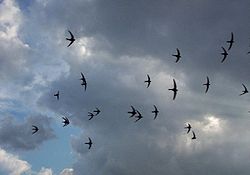| Apus | |
|---|---|
 | |
| Common swifts (Apus apus) | |
| Scientific classification | |
| Domain: | Eukaryota |
| Kingdom: | Animalia |
| Phylum: | Chordata |
| Class: | Aves |
| Clade: | Strisores |
| Order: | Apodiformes |
| Family: | Apodidae |
| Subfamily: | Apodinae |
| Tribe: | Apodini |
| Genus: | Apus Scopoli, 1777 |
| Type species | |
| Hirundo apus [1] Linnaeus, 1758 | |
| Species | |
See text | |
The bird genus Apus comprise some of the Old World members of the family Apodidae, commonly known as swifts.
Contents
They are among the fastest birds in the world. They resemble swallows, to which they are not closely related, but have shorter tails and sickle-shaped wings. Swifts spend most of their life aloft and have very short legs, which they mostly use to cling to surfaces.






